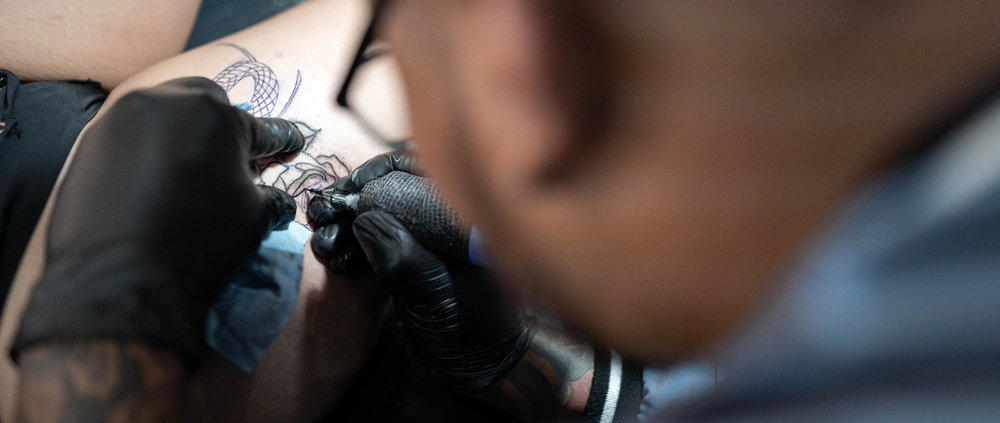Tattoo Weeping: What It Means For Your New Tattoo
So you have just gotten new ink and notice that there is more than blood under the wrapping. For those who have never seen a tattoo weep, the sight of it may be concerning. Tattoo weeping is a common occurrence during the healing stages of a new tattoo. Let’s delve into tattoo weeping, including what it means, why it happens, and when you should be concerned.
Why is My New Tattoo Weeping?
Tattoo weeping, also known as plasma discharge, is a natural part of the healing process. When you get a tattoo, the needle punctures the skin, creating tiny wounds. In response, your body initiates an inflammatory healing response, which includes swelling, redness, and the production of plasma—a clear fluid that helps in the healing process. This plasma may ooze from the tattooed area during the initial days of healing, leading to the phenomenon known as tattoo weeping.
What to Know About the Tattoo Healing Process
Plasma is a natural reaction from the body after a tattoo, but there is more to the healing process than a little bit of tattoo weeping. Let’s look at the healing process, so you can navigate the various phases and keep an eye out for potential complications:
Initial Sensitivity
Immediately after getting a tattoo, your skin will be sensitive, and you may experience various reactions as your body responds to the tattooing process. This includes swelling, redness, and mild discomfort in the tattooed area. These reactions are typical and are part of your body’s natural healing response to the trauma caused by the tattoo needles.
Weeping and Fluid Discharge
During the first few days following the tattooing procedure, it’s common for the tattooed area to weep clear, yellow, or blood-tinged fluids. The presence of this fluid helps to flush out any foreign particles or ink residues from the tattoo site, promoting the healing process. Depending on the size of your tattoo, you may have only a little plasma or a lot. You can expect to see plasma for a few hours or days.
Formation of Scabs
As the healing progresses, the tattooed area may start to form scabs and any weeping will cease. These scabs are composed of dried blood plasma, lymph fluids, and tissue exudates, and they serve as a protective barrier over the wounded skin. It’s important not to pick or scratch the scabs, as doing so can disrupt the healing process and lead to scarring or pigment loss.
Once the scabs fall away, your tattoo will be almost fully healed on the surface. It will take weeks or months for the layers of skin to return to normal.
Extended Causes of Tattoo Weeping
While some tattoo weeping is normal during the initial stages of healing, extended or excessive weeping may indicate other factors at play. One potential cause is the use of too much ointment or moisturizer on the tattooed area. Excessive application of these products can trap moisture and inhibit proper airflow, leading to prolonged weeping.
Additionally, certain individuals may be more prone to tattoo weeping due to their skin type or the specific aftercare products used. If you notice prolonged weeping or excessive fluid discharge from your tattoo, it’s essential to reassess your aftercare routine and consult with your tattoo artist or a dermatologist if necessary.
When Should You Worry About Tattoo Weeping?
Tattoo weeping, although a common occurrence during the initial stages of the healing process, can sometimes indicate underlying issues that require medical attention. While mild weeping is typically considered a normal part of the body’s response to the tattooing process, certain signs and symptoms should prompt you to seek medical advice.
Abnormal Weeping
Normal tattoo weeping will occur within the first few days of your new tattoo. The discharge is typically clear, yellow, or slightly blood-tinged. However, if the discharge becomes less watery, more yellow, or begins to show traces of pus, this is considered abnormal.
Signs of Infection
One of the primary reasons to be vigilant about tattoo weeping is the possibility of infection. If you notice that the discharge from your tattoo has changed in color or consistency, or if you experience other symptoms such as increased redness, warmth, or severe pain in the tattooed area, these may be indicative of an infection. Other signs of infection include the presence of pus, foul odor, or the development of fever.
Keep in mind that ignoring signs of infection or delaying treatment can lead to serious complications, including the spread of infection, tissue damage, or impaired healing of the tattoo.
Looking For a New Tattoo from a Philadelphia Tattoo Shop?
While some degree of weeping is expected during the tattoo healing process, it is important to know when the weeping isn’t normal. Maintain a strict aftercare regimen, and you will notice the weeping cease within a few days as your tattoo begins to heal.
If you’re considering getting a new tattoo and are looking for a reputable tattoo shop in Philadelphia, look no further than Oracle Tattoo Gallery. Our experienced tattoo artists are skilled in various tattoo styles and are committed to providing exceptional service and care to our clients. Whether you’re looking for a small, intricate design or a bold, larger piece, we’ll work with you to bring your vision to life. Contact Oracle Tattoo Gallery today to schedule a consultation and begin your tattoo journey.



